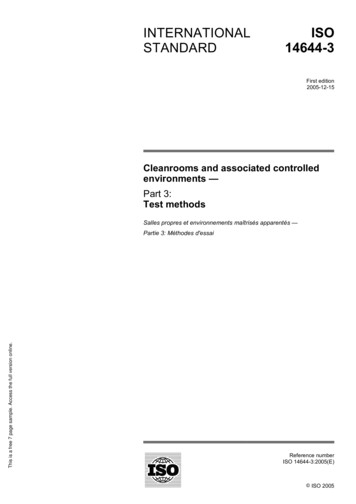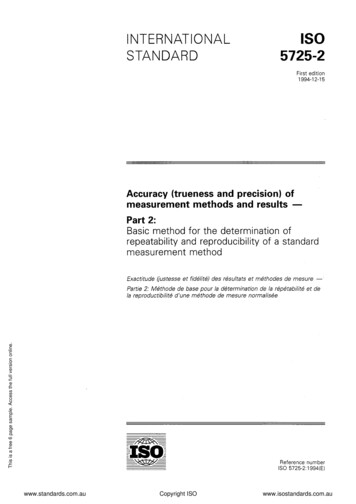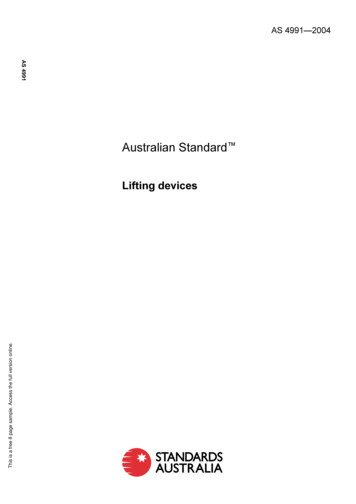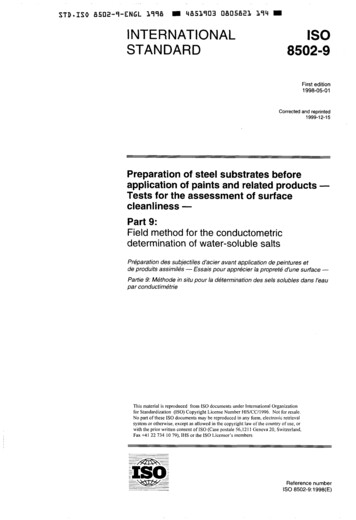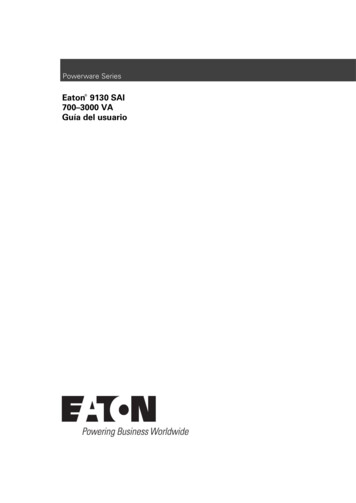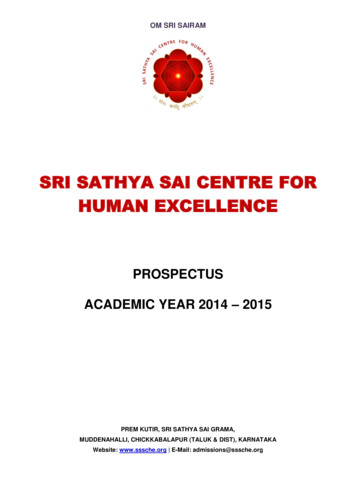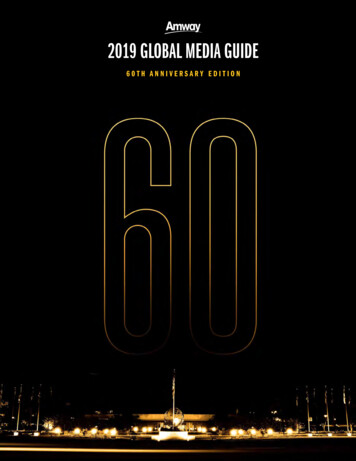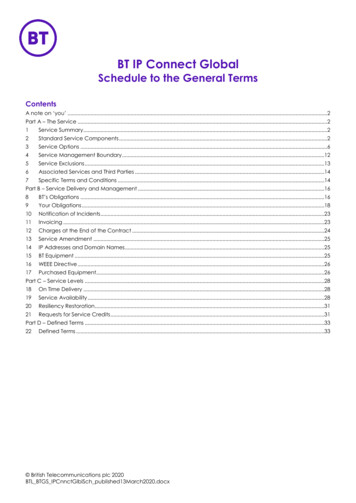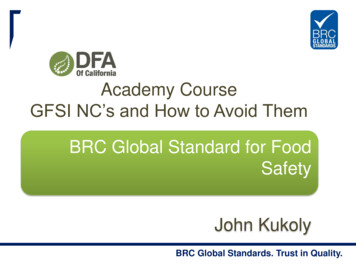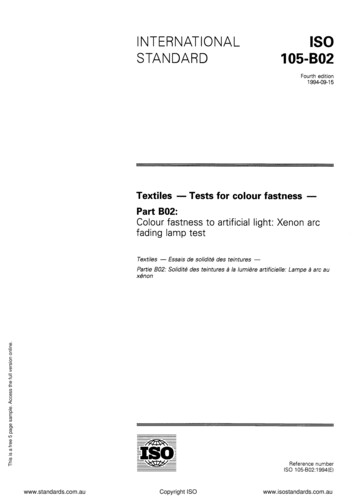
Transcription
IS0105B02INTERNATIONALSTANDARDFourth edition1994-09-I 5Textiles-Tests for colour fastness-Part B02:Colour fastness to artificial light: Xenon arcfading lamp testTextiles -Essais de soliditdes teintures 9 la /urn&eThis is a free 5 page sample. Access the full version online.Par-tie 602: Soliditx&ondes teinturesartificielle:Lampe & arc auReference numberIS0 105-B02:1994(E)www.standards.com.auCopyright ISOwww.isostandards.com.au
IS0 105-B02:1994(E)ForewordIS0 (the International Organization for Standardization) is a worldwidefederation of national standards bodies (IS0 member bodies). The workof preparing International Standards is normally carried out through IS0technical committees.Each member body interested in a subject forwhich a technical committee has been established has the right to berepresented on that committee. International organizations, governmentaland non-governmental, in liaison with ISO, also take part in the work. IS0collaborates closely with the International Electrotechnical Commission(IEC) on all matters of electrotechnical standardization.Draft International Standards adopted by the technical committees arecirculated to the member bodies for voting. Publication as an InternationalStandard requires approval by at least 75 % of the member bodies castinga vote.International Standard IS0 105-B02 was prepared by Technical CommitteeISOFC 38, Textiles, Subcommittee SC 1, Tests for coloured textiles ethird(IS0 105-B02:1988), of which it constitutes a technical revision.editionThis is a free 5 page sample. Access the full version online.IS0 105 was previously published in 13 “parts”, each designated by aletter (e.g. “Part A”), with publication dates between 1978 and 1985. Eachpart contained a series of “sections”, each designated by the respectivepart letter and by a two-digit serial number (e.g. “Section A01 “). Thesesections are now being republished as separate documents, themselvesdesignated “parts” but retaining their earlier alphanumeric designations.A complete list of these parts is given in IS0 105-AOI .Annexes A and B form an integral part of this part of IS0 105. Annex C isfor information only.0 IS0 1994All rights reserved. Unless otherwise specified, no part of this publication may be reproducedor utilized in any form or by any means, electronic or mechanical, including photocopying andmicrofilm, without permission in writing from the publisher.International Organization for StandardizationCase Postale 56 l CH-1211 Geneve 20 l SwitzerlandPrinted in Switzerlandwww.standards.com.auCopyright ISOwww.isostandards.com.au
INTERNATIONALTextilesSTANDARD-IS0 105-B02:1994(E)0 IS0Tests for colour fastness-Part BOZ:Colour fastness to artificial light: Xenon arc fading lamp test1ness co/our.ScopeThis part of IS0 105 specifies a method intended fordetermining the resistance of the colour of textiles ofall kinds and in all forms to the action of an artificiallight source representative of natural daylight (Des).The method is also applicable to white (bleached oroptically brightened) textiles.This method allows the use of two different sets ofblue wool references. The results from the two different sets of references may not be identical.NOTE 1General informationis given in annex C.This is a free 5 page sample. Access the full version online.2Normativeon colour fastnessIS0 105-AO5:4Textiles - Tests for colour fastness- Part A05: Method for the instrumental assessmentof the change in colour of a test specimen.ISO 1050BO1:-*I, Textiles - Tests for colour fastness- Part 801: Co/our fastness to light: Daylight.IS0 105-B05:1993, Textiles ness Part B05: Detectionphotochromism.Tests for co/our fastand assessmentofto lightIS0 3696: 1987, Water for analytical laboratory use Specification and test methods.CIE Publication No. 51, Method for assessingquality of daylight simulators for calorimetry.referencesThe following standards contain provisions which,through reference in this text, constitute provisionsof this part of IS0 105. At the time of publication, theeditions indicated were valid. All standards are subjectto revision, and parties to agreements based on thispart of IS0 105 are encouraged to investigate thepossibility of applying the most recent editions of thestandards indicated below. Members of IEC and IS0maintain registers of currently valid InternationalStandards.IS0 105-AOl : 1994, Textiles - Tests for co/our fastness - Part AOl: General principles of testing.IS0 %05-AO2:1993, Textiles -Part A02: Grey scale for assessing change inTests for co/our fast-3thePrincipleA specimen of the textile to be tested is exposed toartificial light under prescribed conditions, along witha set of blue wool references. The colour fastness isassessed by comparing the change in colour of thetest specimen with that of the references used.For white (bleached or optically brightened) textiles,the colour fastness is assessed by comparing thechange in whiteness of the specimens with that ofthe reference used.1) To be published.2) To be published. (Revision of IS0 105-B01:1989)www.standards.com.auCopyright ISOwww.isostandards.com.au
0 IS0IS0 105-B02:1994(E)4Reference4.1materialsproportions of wool dyed with Cl Mordant Blue 1(Colour Index, third edition, 43830) and wool dyedwith Cl Solubilized Vat Blue 8 (Colour Index, thirdedition, 73801) so that each higher-numberedreference is approximately twice as fast as the precedingreference.and apparatusReference materialsEither of two sets of blue wool references may beused. The results from the two sets of references arenot interchangeable.4.1.3The colour fastness ratings mentioned in this part ofIS0 105 are obtained by comparison with either bluewool references 1 to 8 (preferable in Europe) or bluewool references L2 to L9 (preferable in America).4.1.1ReferencesReferences1 to 8L2 to L9Blue wool references developedUnited States are identified byby the numerical designation 2erences are specially preparedand produced in thethe letter L followedto 9. These eight refby blending varyingTableReference1 -test controlEffective humidity is defined as the combination of airand surface temperaturesand air relative humiditywhich governs the moisture content of the surfaceof the test specimen during exposure. The effectivehumidity can be measured only by determining thecolour fastness of a specific humidity test control.Blue wool references developed and produced inEurope are identified by the numerical designation 1to 8. These references are blue wool cloths dyed withthe dyes listed in table 1. They range from 1 (very lowcolour fastness) to 8 (very high fastness) so that eachhigher-numbered reference is approximately twice asfast as the preceding one.4.1.2HumidityFor the purposes of this part of IS0 105, the humiditytest control is a red azoic dyed cotton cloth.This control has been calibrated by exposing it facingsouth in several Western European locations at different times of the year, the exposures being madetogether with the references in sealed vessels containing air maintained at constant humidities between0 and 100 %; the results did not vary greatly and themean values are shown in figure 1.When this control was exposed under the conditionsspecified in IS0 105-BOl in temperate zones, itscolour fastness was found to be, on average, 5.Dyes for blue wool references1 to 8Dye (Colour Index designation)1)Cl Acid Blue 104Cl Acid Blue 109Cl Acid Blue 83This is a free 5 page sample. Access the full version online.Cl Acid Blue 121Cl Acid Blue 47Cl Acid Blue 23Cl Solubilized Vat Blue 58Cl Solubilized Vat Blue 81) The Colour Index (third edition) is published by the Society of Dyers andColourists, P.O. Box 244, Perkin House, 82 Grattan Road, Bradford BDI ZJB,West Yorks, UK, and by the American Association of Textile Chemists andColorists, P.O. Box 12215, Research Triangle Park, NC 27709-2215, USA. 2www.standards.com.auCopyright ISOwww.isostandards.com.au
IS0 5060708090 100Effective humidity, %Figure4.21 -Mean values obtainedwww.standards.com.auconditionspreferablea well-ventilatedexposureb) Light filter, placed between the light source andthe specimens and references so that the ultraviolet spectrum is steadily reduced.The transmission of the filter system used shallbe at least 90 % between 380 nm and 750 nm,falling to 0 between 310 nm and 320 nm.c)The distances from the surface of the specimen andfrom the surfaces of the references to the lamp shallbe the same.4.2.1.1 Air-cooled xenon arc lamp apparatusannex A), consisting of the following elements:inexposuresThe light source shall consist of a xenon arc lampof correlated colour temperature5 500 K to6 500 K, the size of which will depend on the typeof apparatus used.either air-cooledThe specimens and the references are exposed in oneof the two types of apparatus (see 4.2.1 .l and4.2.1.2). The variation in light intensity over the areacovered by the specimens and references shall notexceed 10 % of the mean. The recommended levelof irradiance (radiant power per unit area) measuredby a radiometer (4.2.6) is 42 W/m’ x wavelength, innanometres, at 300 nm to 400 nm, equivalent incases of water-cooledxenon arc apparatus to1,l W/m* x wavelength, in nanometres, at 420 nm.NOTE 2For exposureEurope, see 6.1.test controla) Light source,chamber.Apparatus4.2.1 Xenon arc lamp apparatus,or water-cooled.This is a free 5 page sample. Access the full version online.from humidity(seeHeat filter, placed between the light source andthe specimens and references so that the amountof infrared (IR) radiation contained in the xenon arcspectrum is steadily reduced (see A.1 .l andA.2.2).If a glass or water filter is used to eliminate excess infrared radiation so as to meet the temperature conditions specified in 4.2, frequentcleaning shall be carried out to avoid unwantedfiltering caused by dirt (see B.l.4).for use inCopyright ISOwww.isostandards.com.au
This is a free 5 page sample. Access the full version online.ISO 105-B02:1994 Textiles - Tests for colour fastness - PartB02: Colour fastness to artificial light: Xenon arc fading lamptestThe remainder of this documentis available for purchase online atwww.saiglobal.com/shopSAI Global also carries a wide range of publications from a wide variety of Standards Publishers:Click on the logos to search the database online.
IS0 105-B02:1994(E) Foreword IS0 (the International Organization for Standardization) is a worldwide federation of national standards bodies (IS0 member bodies). The work of preparing International Standards is normally carried out through IS0 technical committees. Each member body interested in a subject for which a technical committee has been established has the right to be represented on .
